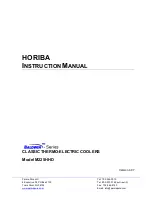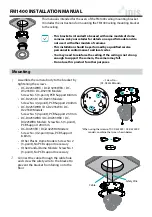
Section C: Principle of Operation
7
Figure 2: Heat Exchanger, Impinger and Heat Sink Assembly
transferred to the hot side of the Peltier element where it is dissipated into the heat
sink and surrounding environment.
Baldwin-Series Classic Thermo-Electric Coolers remove the moisture from the
sample gas by cooling the gas as it passes through a laminar impinger (heat
exchanger). A diagram showing the gas flow path through an impinger is shown in
the Appendix. The heat exchanger, made of 316L stainless steel, Durinert
®
(a
corrosion-resistant inert coating over 316L stainless steel), PVDF (Kynar), or glass,
is mounted within a thermally insulated heat transfer block bored to receive the heat
exchanger without a mechanical lock. This assembly allows the easy removal of any
heat exchanger simply by slipping it out of the cooling block by hand. The heat
transfer block cools the heat exchanger through the heat pumping action of the
peltier element. The heat transfer block is on the cold side of the thermo-electric
element and the heat sink is on the hot side of the thermo-electric element. The
heat from the heat transfer block is pumped to the heat sink where it is then
dissipated into the air by the heat sink fan. See Figure 2. The desired temperature
is maintained by a closed loop control system, which is implemented through an
analog proportional controller. The controller uses a type K thermocouple in the
heat transfer block located very close to the cold side of the peltier element as the
input sensor.
The sample gas is passed to the Classic Thermo-Electric Cooler via the heated filter
sample probe and heated sample line. The Classic Thermo-Electric Cooler lowers
the sample dew point to 5
o
C (41
°
F). As the gas cools and the moisture vapor
Содержание HORIBA Baldwin M225HHD
Страница 20: ...21 APPENDIX A CLASSIC MODEL M225HHD...
Страница 21: ......
Страница 22: ......
Страница 23: ......
Страница 24: ......







































